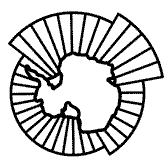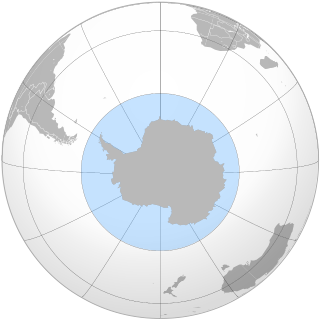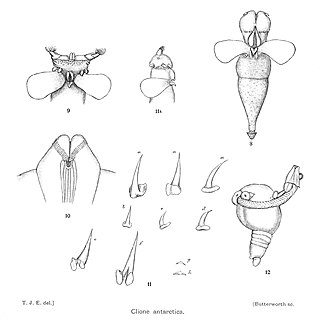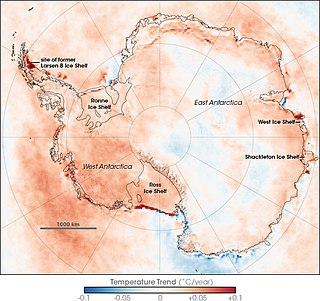
The Antarctic is a polar region around Earth's South Pole, opposite the Arctic region around the North Pole. The Antarctic comprises the continent of Antarctica, the Kerguelen Plateau and other island territories located on the Antarctic Plate or south of the Antarctic Convergence. The Antarctic region includes the ice shelves, waters, and all the island territories in the Southern Ocean situated south of the Antarctic Convergence, a zone approximately 32 to 48 km wide varying in latitude seasonally. The region covers some 20 percent of the Southern Hemisphere, of which 5.5 percent is the surface area of the Antarctica continent itself. All of the land and ice shelves south of 60°S latitude are administered under the Antarctic Treaty System. Biogeographically, the Antarctic realm is one of eight biogeographic realms of Earth's land surface.

The Ross Sea is a deep bay of the Southern Ocean in Antarctica, between Victoria Land and Marie Byrd Land and within the Ross Embayment, and is the southernmost sea on Earth. It derives its name from the British explorer James Clark Ross who visited this area in 1841. To the west of the sea lies Ross Island and Victoria Land, to the east Roosevelt Island and Edward VII Peninsula in Marie Byrd Land, while the southernmost part is covered by the Ross Ice Shelf, and is about 200 miles (320 km) from the South Pole. Its boundaries and area have been defined by the New Zealand National Institute of Water and Atmospheric Research as having an area of 637,000 square kilometres (246,000 sq mi).

The Convention on the Conservation of Antarctic Marine Living Resources, also known as the Commission for the Conservation of Antarctic Marine Living Resources, and CCAMLR, is part of the Antarctic Treaty System.

A salp or salpa is a barrel-shaped, planktic tunicate. It moves by contracting, thereby pumping water through its gelatinous body, one of the most efficient examples of jet propulsion in the animal kingdom. The salp strains the pumped water through its internal feeding filters, feeding on phytoplankton.

Lepetellidae is a taxonomic family of small deepwater sea snails or limpets, marine gastropod molluscs in the superfamily Lepetelloidea in the clade Vetigastropoda. .

Antarctica is Earth's southernmost and least-populated continent. Situated almost entirely south of the Antarctic Circle and surrounded by the Southern Ocean, it contains the geographic South Pole. Antarctica is the fifth-largest continent, being about 40% larger than Europe, and has an area of 14,200,000 km2 (5,500,000 sq mi). Most of Antarctica is covered by the Antarctic ice sheet, with an average thickness of 1.9 km (1.2 mi).

The Southern Ocean, also known as the Antarctic Ocean, comprises the southernmost waters of the world ocean, generally taken to be south of 60° S latitude and encircling Antarctica. With a size of 20,327,000 km2 (7,848,000 sq mi), it is regarded as the second-smallest of the five principal oceanic divisions: smaller than the Pacific, Atlantic, and Indian oceans but larger than the Arctic Ocean. Since the 1980s, the Southern Ocean has been subject to rapid climate change, which has led to changes in the marine ecosystem.
Lepetella laterocompressa is a species of sea snail, a marine gastropod mollusk in the family Lepetellidae.
Lepetella espinosae is a species of sea snail, a marine gastropod mollusk in the family Lepetellidae.
Lepetella barrajoni is a species of sea snail, a marine gastropod mollusk in the family Lepetellidae.
Lepetella tubicola is a species of sea snail, a marine gastropod mollusk in the family Lepetellidae.
Lepetella sierrai is a species of sea snail, a marine gastropod mollusk in the family Lepetellidae.
Lepetella is a genus of very small deep-sea sea snails or limpets, marine gastropod mollusks in the family Lepetellidae.

Clione antarctica is a species of "sea angel", a sea slug, a pelagic marine gastropod mollusk in the family Clionidae, the "sea angels".

The wildlife of Antarctica are extremophiles, having to adapt to the dryness, low temperatures, and high exposure common in Antarctica. The extreme weather of the interior contrasts to the relatively mild conditions on the Antarctic Peninsula and the subantarctic islands, which have warmer temperatures and more liquid water. Much of the ocean around the mainland is covered by sea ice. The oceans themselves are a more stable environment for life, both in the water column and on the seabed.

Temperature change due to climate change in Antarctica is not stable over the whole continent. West Antarctica is warming rapidly, while the inland regions are cooled by the winds in Antarctica. Water in the West Antarctic has warmed by 1 °C since year 1955. Further increase in temperature in water and on land will affect the climate, ice mass and life on the continent and have global implications. Present-day greenhouse gas concentrations are higher than ever according to ice cores from Antarctica, which indicates that warming on this continent is not part of a natural cycle and attributable to anthropogenic climate change.
Urticinopsis antarctica is a species of sea anemone in the family Actiniidae. It is found in the Southern Ocean around Antarctica.
Isotealia antarctica, the salmon anemone, is a species of sea anemone in the family Actiniidae. It is found in the southern Atlantic and Pacific Oceans and the waters around Antarctica. It is a filter feeder and opportunistic predator.
Tritoniella is a genus of sea slugs, specifically dendronotid nudibranchs. It is a marine gastropod mollusc in the family Tritoniidae.The genus was described in 1907 by the British diplomat and malacologist Charles Eliot.









